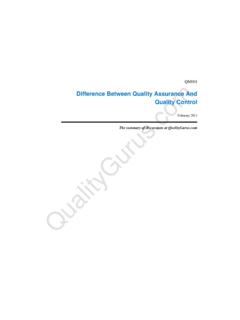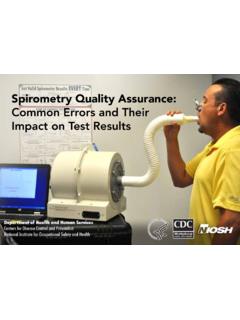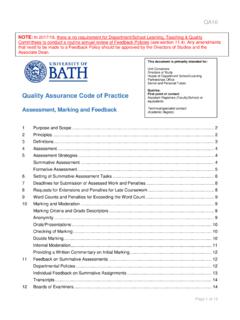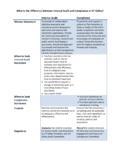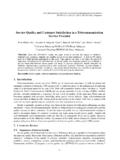Transcription of Grower Guide: Quality Assurance of Biocontrol …
1 Grower Guide: Quality AssuranceofBiocontrol ProductsCompiled byRose Buitenhuis,PhD, Research Scientist, Biological Control,Vineland Research and Innovation Centre, 2014; Updated October 2017 Purpose of Guide Successful biocontrolprograms are dependent on a number of factors, but good Quality natural enemies are fundamental. However, as living organisms, biocontrolproducts are subject to variability caused by various factors, starting at the insectarywhere they are reared through to the crop where they are released. Production of biocontrolagents is a self-regulated industry and Quality assessments by the end-users are important to provide producers with feedback and to maintain high Quality suppliers are facing the challenge of producing a constant and reliable supply of high Quality natural enemies.
2 Therefore, Quality control (QC) checks are done at the supplier level to make sure the products meet certain standards before they are shipped to the customer. However, it often takes several days before the products arrive at the Grower and are released into the greenhouse. During this time, uncontrolled packaging, transport and storage conditions may affect the Quality of the product and therefore the performance in pest control. Shipping is probably the most critical period. Temperature extremes, condensation from ice packs, restricted oxygen supply, unnatural high population densities and long shipping and storage times are some of the factors that can adversely affect Quality .
3 Therefore, growers should open packages upon arrival to provide a better environment for the biocontrolagents and to detect any potential problems related to shipping conditions (too warm, too cold, wet, bad smell).In an ideal situation, growers would perform Quality checks on every biocontrolproduct they receive as Quality will directly impact efficacy; a shipment of poor- Quality can result in failure to control the target pest. If a Quality issue is detected the Grower can react proactively, adjusting release rates guidelines at receipt of a package, look for condensation or fermenting smell, temperature of products: look for movement, when applicable shipped as pupae or mummies, record the number of emerging on QC tests at the producer, more product might be present in the container than stated on the label to compensate for low emergence or high both adult females and males are present, sex ratio should be at least 40-45% good records.
4 Take notes of species name, packaging type/size, date received, company batch number, date tested, method used, number of samples, number of biocontrolagents counted and any other observations on the appearance and performance of the a potential problem is detected, communicate with the supplier. Note that the small number of samples recommended in this guide tends to underestimate the total number of biological control agents in the package. If the tests indicate that the package contains less than 70% of the biological control agents, a problem should be completing this general check, you can proceed to the Quality checks pertaining to the specific Biocontrol agent you have received.
5 ContactRose Buitenhuis,PhD Research Scientist, Biological x7494890 Victoria Avenue North, Vineland Station, ON L0R 2E0 AcknowledgementsFundingVineland Research and Innovation Centre, Flowers Canada Ontario, Association of Natural Biocontrol Producers, IPM Florida, USDA,National Institute of Food and Agriculture, Extension IPMS ourcesVan Lenteren, J. C., Hale, A., Klapwijk, J. N. 2003: Guidelines for Quality control of commercially produced natural enemies. In: Quality control and production of biological control agents. Theory and testing procedures.
6 Van Lenteren, , (ed.): pp. 265-303. CAB , B. Applied Bio-nomics, Quality Assurance at the Grower level. , B. and C. Glennister, 2005, Appendix D. Quick methods for evaluating biocontrolshipments. In: Moorman, , and R. Berghage, eds. Total Crop Management in Greenhouses: A Guide to Greenhouse Crop Production. Penn State Cooperative ExtensionPhoto creditsPictures have been generously provided by IQDHO (InstitutQu becoisdu D veloppementde l HorticultureOrnementale), the Bug Factory, Biobest, Koppert, Beneficial Insectary, Applied Bionomics, Syngenta, Clark, Mike CopelandThanks to Kate Book, Ashley Summerfield, Rebecca Eerkes, Erik Glemserand all people who helped reviewing the needed to do Quality checks:Many of the materials can be obtained from companies selling entomological supplies (for example www.)
7 , an art store (paintbrushes) or the supermarket (cups). For ventilation holes in cups and containers, attach fine mesh insect screening over the hole with hot glue. Contact your extension person or consultant for more suggestions on where to get lensMicroscopeMechanical aspiratorFine mesh cageScreened cup with lidCotton wool and sugar waterScreened deli containerYellow sticky cards Handlens(at least 10X magnification) Stereomicroscope (up to 40X magnification) Aspirator (It is recommended to use a power-insect aspirator instead of a mouth-insect aspirator to prevent inhalation of small particles or contaminants)
8 Fine paintbrush Fine mesh cage, Bugdorm Deli cups/drink cups with screened ventilation holes and lid Sugar water (mix 40g sugar + 60 ml warm water) or honey Yellow sticky cards White paper or tray Measuring cups, teaspoon (5 ml), tablespoon (15 ml)White trayMeasuring spoonsProtocols By SpeciesAphelinus abdominalisAphidius aphidimyzaGreen lacewing (Chrysoperlacarnea, C. rufilabris)Cryptolaemus montrouzieriDacnusa sibericaDalotia (=Atheta) coriariaDelphastus catalinaeDicyphus hesperusDiglyphus isaeaEncarsia formosaEretmocerus acarisugaHippodamia convergensand other ladybeetlesLeptomastix dactylopiiOrius mites(Amblyseiusdegenerans, Amblyseiusswirskii, Amblyseiusandersoni, Neoseiuluscalifornicus, Neoseiuluscucumeris, Neoseiulusfallacis,Phytoseiulus persimilis)
9 Phytoseiulus persimilison leavesSteinernema feltiaeand other beneficial nematodesStethorus punctillumStratiolaelaps scimitus(=Hypoaspismiles)Trichogramma abdominalisFrom left to right: Aphelinus mummies (The Bug Factory), cage set-up, collecting Aphelinus adults from cage (Vineland Research and Innovation Centre).Difference between males and femalesFemales have a yellow abdomen with an ovipositor (small stripe over the middle of the abdomen). Males are usually smaller and have a slightly darker abdomen. Signs of activity in the cropParasitized aphids (black mummies) after about 8 daysFrom left to right: Aphelinusadult female (Syngenta), Aphelinusmummies on foliage (Biobest).
10 Packaging Mummies in vial, few adults starting to emerge Quality assessment at arrivalPlace all material from the vial in a fine mesh screen cage. Provide a few drops of honey or cotton wool drenched with sugar water as food for emerged adults. Place in a shaded area. Every day, aspirate and count emerged adults out of the cage and release them in the Mummies in vial, few adults starting to assessment at arrivalPlace all material from the vial in a fine mesh screen cage. Provide a few drops of honey or cotton wool drenched with sugar water as food for emerged adults.
